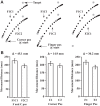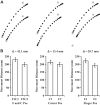Contributions of exercise-induced fatigue versus intertrial tendon vibration on visual-proprioceptive weighting for goal-directed movement
- PMID: 32755335
- PMCID: PMC7509304
- DOI: 10.1152/jn.00263.2020
Contributions of exercise-induced fatigue versus intertrial tendon vibration on visual-proprioceptive weighting for goal-directed movement
Abstract
It has been argued that exercise-induced muscle fatigue and tendon vibration can alter proprioceptive estimates of limb position. While exercise-induced muscle fatigue may also affect central efferent processes related to limb position sense, tendon vibration specifically targets peripheral afferent signals. It is unclear, however, whether either of these perturbations (i.e., muscle fatigue or tendon vibration) can alter the multisensory weighting processes preceding goal-directed movements. The current study sought to specifically explore visual-proprioceptive weighting before or after eccentric exercise-induced antagonist muscle fatigue (experiment 1) versus with or without intertrial simultaneous agonist-antagonist tendon vibration (experiment 2). To assess sensory weighting, a visual-proprioceptive mismatch between the participant's actual initial starting position and the associated visual cursor position was employed. This method provides an estimate of the participant's reliance on the proprioceptive or visual starting limb position for their aiming movements. Although there was clear evidence of muscle fatigue, there was no systematic alteration of proprioceptive weighting after eccentric exercise and no relationship between sensory weighting and the level of fatigue. On the other hand, participants' reliance on their actual (proprioceptive) limb position was systematically reduced when exposed to agonist-antagonist tendon vibration before each aiming movement. These findings provide seminal evidence that intertrial tendon vibration, but not exercise-induced fatigue, can alter the reliability of proprioceptive estimates and the relative contributions of visual and proprioceptive information for goal-directed movement.NEW & NOTEWORTHY Previous work has used muscle fatigue or tendon vibration to perturb proprioceptive limb position estimates. This study sought to determine whether exercise-induced muscle fatigue versus intertrial tendon vibration can alter multisensory weighting for upper limb-aiming movements. By introducing a discrepancy between participants' actual proprioceptive and visual finger position, this study provides seminal evidence for the reduction of proprioceptive-to-visual weighting using intertrial tendon vibration but no evidence for a systematic reduction following exercise-induced fatigue.
Keywords: action; multisensory; muscle fatigue; proprioception; tendon vibration; visual.
Conflict of interest statement
No conflicts of interest, financial or otherwise, are declared by the authors.
Figures








References
Publication types
MeSH terms
LinkOut - more resources
Full Text Sources
Medical

